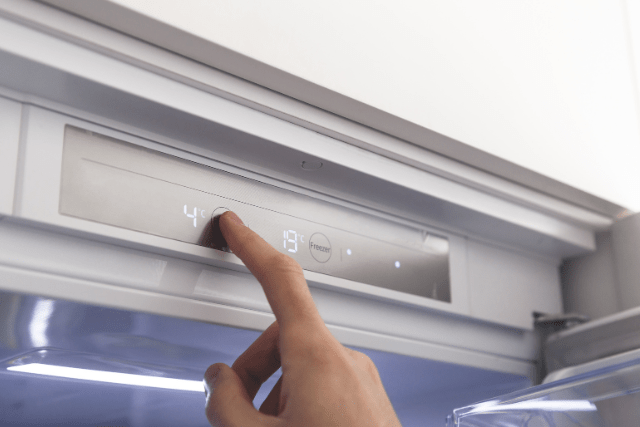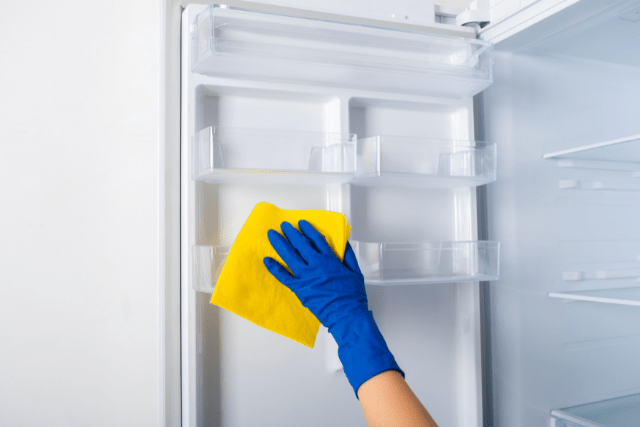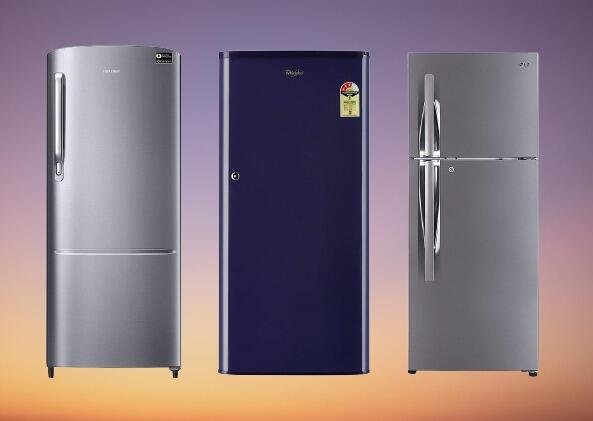Frost buildup in your freezer not only affects the efficiency of your appliance but can also lead to spoiled food and increased energy consumption.
Fortunately, you can employ several tips and techniques to keep frost at bay. This guide will explore effective ways to prevent frost buildup and maintain a frost-free freezer.
At a Glance
A frost-free freezer saves you time and conserves energy, making it a valuable addition to your kitchen. Incorporating these 13 proven tips into your freezer maintenance routine will keep your freezer frost-free, efficient, and your frozen foods in optimal condition.
Key Takeaways
- Maintain the ideal freezer temperature between -18°C to -20°C to slow bacteria growth and prevent ice crystals.
- Minimize door openings to maintain a consistent temperature, preserve food quality, and reduce energy consumption.
- Use airtight containers or bags to prevent moisture and air from entering the freezer, preventing frost formation and freezer burn.
- Avoid overloading the freezer to ensure proper air circulation, improve efficiency, and maximize space utilization.
1. Set the Temperature Properly
Setting the freezer temperature correctly is crucial to ensure optimal performance and prevent frost buildup.
The ideal temperature for a freezer is between -18°C to -20°C (-0.4°F to -4°F). The freezer can effectively preserve food at this temperature range by slowing bacteria growth and preventing ice crystal formation.

However, setting the temperature too low can lead to excessive energy consumption and freezer burn. On the other hand, setting it too high can cause food to spoil quickly.
It is recommended to use a digital thermometer to check the freezer temperature regularly and adjust accordingly.
Ensure the freezer door is properly sealed to maintain a consistent temperature inside.
2. Organize Your Freezer Efficiently
Properly organizing your freezer is essential for maximizing efficiency and preventing frost buildup.
It is important to categorize and label your frozen items. This helps you find what you need quickly and reduces the time the freezer door is open, minimizing temperature fluctuations.
Group similar items together, such as meats, vegetables, and desserts, and use clear containers or bags to identify their contents easily.
Utilize the space in your freezer efficiently. Arrange items in a way that allows for proper airflow, ensuring that the cold air circulates evenly throughout.
Stack items neatly, with the oldest items in the front for easy access and to prevent them from being forgotten and going to waste.
Regularly declutter and remove any expired or freezer-burned items. This not only frees up space but also prevents odors and maintains a clean and hygienic freezer environment.
3. Keep the Door Closed as Much as Possible
Minimize unnecessary temperature fluctuations by keeping the freezer door closed as much as possible.
This simple practice can significantly extend the lifespan of your freezer and ensure optimal food preservation.

Three reasons why keeping the freezer door closed is crucial?
- Temperature stability: Opening the door allows warm air to enter, causing the temperature inside to rise. This can lead to frost build-up and spoilage of stored food items. By minimizing door openings, you maintain a consistent temperature, preserving the quality and freshness of your frozen goods.
- Energy efficiency: Each time the door is opened, cold air escapes, and the freezer has to work harder to restore the desired temperature. By reducing door openings, you conserve energy and lower your electricity bills.
- Frost prevention: Opening the freezer door introduces moisture, which can condense and form frost on the walls and shelves. Keeping the door closed helps prevent frost accumulation, making defrosting less frequent and more manageable.
4. Use Airtight Containers or Bags
Utilize airtight containers or bags to maintain optimal freezer conditions and prevent frost accumulation.
Airtight containers or bags play a crucial role in preserving the quality of frozen foods by preventing the entry of moisture and air.
Moisture and air, when exposed to low temperatures, can lead to frost formation, causing freezer burn and compromising the taste and texture of the food.
Airtight containers create a barrier that seals the food’s natural moisture and prevents it from evaporating.

Similarly, airtight bags create a protective layer around the food, preventing air and moisture from seeping in.
These containers or bags ensure that your frozen items remain fresh, flavorful, and frost damage-free.
5. Avoid Overloading the Freezer
It is important to avoid overloading the freezer to maintain optimal freezer conditions and prevent frost accumulation.
Overloading the freezer can lead to poor air circulation, uneven cooling, and increased energy consumption.
You can consider the following tips:
- Organize and prioritize: Systematically arrange your frozen items, ensuring that the most frequently used items are easily accessible. This will prevent rummaging through the freezer and disturbing the contents.
- Use freezer-safe containers: Transfer bulky items into smaller, airtight containers to maximize space utilization. This will not only help you fit more items but also prevent freezer burn and maintain the quality of your food.
- Regularly declutter: Take the time to declutter your freezer and remove expired or unnecessary items. This will create more space and improve the overall airflow within the freezer.
6. Regularly Clean and Defrost Your Freezer
Cleaning and defrosting your freezer helps remove frost buildup and extends your appliance’s lifespan.

Make it a routine to check and clean your freezer at least once or twice a year, depending on how often frost accumulates.
7. Check for and Fix Any Leaks or Gaps
One important step in maintaining a frost-free freezer is regularly checking for and repairing any leaks or gaps.
Even the smallest gaps can allow warm air to enter the freezer, causing frost to accumulate.
To ensure your freezer remains frost-free, follow these tips:
- Inspect the door seal: Check the condition of the door seal and ensure it is free from any cracks or tears. A damaged seal can result in air leakage, leading to frost buildup. Replace the seal if necessary.
- Examine the freezer walls: Carefully inspect the walls of your freezer for any cracks or gaps. These can occur over time due to wear and tear or improper installation. Seal any openings using a silicone-based adhesive to prevent warm air infiltration.
- Check the freezer vents: Make sure the vents inside the freezer are not blocked by food or other items. Blocked vents can disrupt the airflow and lead to frost formation. Regularly clean and clear any obstructions to maintain proper ventilation.
8. Use a Fan to Circulate Air Inside the Freezer
Regularly using a fan to circulate air inside the freezer can help prevent frost buildup. By keeping the air in constant motion, a fan ensures that the temperature inside the freezer remains consistent throughout.
This prevents frost formation on the walls and shelves of the freezer, as well as on the stored food items.
The circulating air helps to distribute the cold air more evenly, preventing warm spots that can lead to condensation and frost formation.
The movement of air helps to remove excess moisture from the freezer, reducing the likelihood of frost accumulation.
It is important to position the fan strategically, ensuring that it does not obstruct the airflow or interfere with the proper functioning of the freezer.
Regularly cleaning the fan to remove dust and debris is also essential for optimal performance.
9. Place a Layer of Newspaper or Cardboard on the Bottom
A practical method to prevent frost buildup in your freezer is adding a newspaper or cardboard layer on the bottom.
This simple yet effective technique helps to insulate the freezer and minimize cold air loss.
Here’s how it works:
- Insulation: Placing a newspaper or cardboard layer on the freezer’s bottom creates a barrier between the freezer floor and the items inside. This insulation prevents direct contact between the cold surface and the food, reducing the chances of frost formation.
- Absorption: Newspaper and cardboard have absorbent properties that can help to collect excess moisture and condensation within the freezer. By absorbing this moisture, the newspaper or cardboard layer helps maintain a dry environment, further preventing frost accumulation.
- Easy Maintenance: Cleaning can be a hassle when frost forms on the freezer walls or shelves. However, the frost buildup is significantly reduced with a layer of newspaper or cardboard on the bottom. This makes it easier to maintain a frost-free freezer and saves you time and effort in the long run.
10. Avoid Placing Hot or Warm Items in the Freezer
To maintain a frost-free freezer, it is advisable to avoid placing hot or warm items in the freezer.
When hot or warm items are placed in the freezer, it disrupts the temperature balance within the appliance, causing the freezer to work harder to cool down and maintain its desired temperature.
This additional workload can lead to the formation of frost and ice buildup. Furthermore, introducing hot or warm items can accelerate the thawing process of frozen food items in the freezer, potentially compromising their quality and safety.
It is recommended to allow hot or warm items to cool down to room temperature before placing them in the freezer.
11. Keep the Freezer Well-Stocked
Maintaining a well-stocked freezer is essential for preventing frost buildup and ensuring optimal performance.
A freezer with empty spaces allows warm air to circulate, leading to condensation and ice formation.

A well-stocked freezer has the following benefits:
- Improved temperature stability: A fully stocked freezer retains cold temperatures more effectively than an empty one. The stored items act as thermal mass, helping to maintain a consistent temperature and reducing the need for the compressor to work excessively.
- Faster freezing: When a freezer is filled with food, the thermal mass helps to absorb heat from newly added items, promoting faster freezing. This ensures the food is frozen quickly, preserving its quality and taste.
- Energy efficiency: A well-stocked freezer requires less energy to maintain the desired temperature. The stored items help to insulate the freezer, reducing the workload on the compressor and lowering energy consumption.
12. Consider Using Freezer Mats or Liners
Using freezer mats or liners can help prevent frost buildup and make cleaning your freezer easier.
Freezer mats or liners act as a protective barrier between the food and the freezer surfaces, preventing moisture from accumulating and forming frost.
These mats are usually made of durable, moisture-resistant materials that can be easily cleaned. They are designed to fit the dimensions of your freezer shelves or drawers, providing a seamless and hygienic solution.
Freezer mats or liners can help extend the lifespan of your freezer by reducing the need for manual defrosting, which can be time-consuming and labour-intensive.
Invest in high-quality freezer mats or liners to maintain a clean, frost-free freezer environment.
13. Buy a Frost-Free Freezer
If you are currently shopping for a new freezer, it’s worth seriously considering investing in a frost-free model.
These freezers have built-in defrost systems that automatically and periodically eliminate ice and frost. This feature plays a pivotal role in maintaining your freezer’s frost-free condition.
Frost-free freezers work by cycling through periods of cooling and warming. During the warming phase, any accumulated frost melts and is drained away, leaving the freezer free from ice buildup.

This automatic defrosting system saves you the hassle of manual defrosting and ensures your freezer remains in optimal working condition.
Opting for a frost-free freezer is convenient and effective for those looking to minimize the challenges associated with frost accumulation, making it a smart addition to your home appliance collection.
Frequently Asked Questions
How Often Should I Clean and Defrost My Freezer?
It is recommended to clean and defrost your freezer every 3-6 months. Regular maintenance helps prevent frost buildup, ensures efficient cooling, and extends the lifespan of your freezer.
What Temperature Should I Set My Freezer To?
The ideal temperature to set your freezer is 0 degrees Fahrenheit (-18 degrees Celsius). This temperature ensures that food is frozen and safe for consumption while minimizing frost formation.
Can I Use Regular Plastic Bags Instead of Airtight Containers?
Using regular plastic bags instead of airtight containers in your freezer may lead to freezer burn and loss of food quality. Airtight containers provide better protection against moisture and air, preventing frost buildup and maintaining optimal conditions for frozen food storage.
How Do I Fix Leaks or Gaps in My Freezer?
To fix leaks or gaps in your freezer, start by identifying the source of the problem. Common causes include damaged door seals, faulty gaskets, or cracks in the freezer walls. Once identified, repair or replace the affected parts to ensure proper insulation and prevent frost formation.
Are Freezer Mats or Liners Necessary?
Freezer mats or liners can be a useful addition to your freezer. They help to prevent frost buildup, provide insulation, and make cleaning easier. While not necessary, they can help maintain optimal freezer conditions.
Conclusion
Preventing frost buildup in your freezer is essential for maintaining the efficiency of your appliance and ensuring the longevity of your frozen foods.
By following the tips and techniques outlined in this guide, you can significantly reduce the occurrence of frost and keep your freezer operating at its best.
Good luck!







